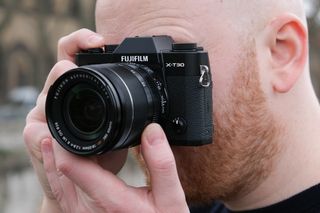Why you can trust TechRadar
Build and handling
- Weighs just 383g (with battery and card but without lens)
- 1.3mm thinner LCD screen than the X-T20
- New grip shape to provide better telephoto lens support
Externally, not much has changed between the X-T20 and X-T30. The basic format is still the same, with the X-T30 having a smaller but slightly boxier body than the more senior X-T3 on which it's based, and a twin-command-dial setup for DSLR-like operation. The triplet of dials on the top plate to adjust drive mode, shutter speed and exposure compensation remain from the X-T20, with aperture changed either via the ring on the mounted lens or the dial on the camera.
The grip has been subtly restyled in order to provide better support for longer and heavier lenses. This is very welcome on a camera as small and light as this one, but even so, the grip doesn't even protrude a full centimeter away from the body. This is clearly a camera that's designed to be used with the smaller and lighter lenses in the series. XC and XF
Most of the changes between the X-T20 and X-T30 are on the rear. The X-T20's D-Pad, which offered left, right, up and down buttons together with a central Menu/OK button, has been replaced by a joystick-like Focus Lever. This has pushed the Q button to the upper-right-hand side of the back panel, to a small but more defined platform than on the X-T20, and this has also freed up space for the thumb to rest more comfortably than before.
The changes here result in something of a mixed bag when it comes to handling and operation. First, while the thumb has just enough space to rest easily, it will naturally fall in the way of the status lamp, which tells you when exposure settings aren't right, when images are being written to the card and so on. Clearly it's useful to keep an eye on this lamp as you shoot, but its placement on such a small camera doesn't really allow you to do so, unless you keep moving your thumb out of the way.

The focus lever is also just a few millimeters away from the edges of the LCD screen, which isn't an issue until you pull the LCD screen away from the body, at which point the proximity of the two makes the lever difficult to operate; those shooting with their left eye to the viewfinder will also find it awkward to operate without their nose being in the way. That said, the focus lever is useful for moving through the menus and shift the focusing point. It also responds perfectly well to diagonal movements – not something every other control of this type can manage – although it's so small that it's easy to hit it either left, right, up or down when you want to move diagonally.
The LCD screen itself is also now 1.3mm thinner the the X-T20's, which means it sits more flush with the back of the camera. Despite this, the gap between its base and the camera's back plate allows you to easily pull it away at speed when you need to adjust it to a different position. It also extends far enough away from the body or the eyecup to not be in the way when you're looking at the screen from above – again, a sore point on many other cameras.







That fact that the LCD screen is so close to the back of the camera, however, means the eye sensor underneath the viewfinder is easily fooled into thinking your face is approaching, and so it tends to deactivate the display when you're using the touchscreen. Unless you deactivate the automatic switching between the two, you may find this to be annoying.
Otherwise, operation is generally very good. The camera is ready for action almost as soon as you turn it on, and it responds promptly to commands. The dials on the top plate turn easily, and while the exposure compensation dial can still occasionally get knocked out of place, Fujifilm's efforts to make this less of an issue than on the X-T20 do appear to have made a slight difference for the better.
One oddity from the X-T20 has remained, namely the position of the tripod thread right next to the door to the battery and memory card compartment. This makes it impossible to access either the card or battery when the camera is mounted on a tripod, and there seems to be no good reason why the thread couldn't simply have been shifted an inch or so nearer to the middle of the base plate to remedy the issue.
Autofocus
- Hybrid phase- and contrast-detect AF system
- 425 addressable AF points
- Face and Eye Detection works well
The X-T30 understandably differs from the X-T3 in a number of ways, but its autofocus system is essentially the same. In fact, in some ways it's actually a little more advanced, although the X-T3 will gain some of the extra features on offer here through an upcoming firmware update.
The use of the same 26.1MP sensor as the X-T3 means it has the same 2.16 million phase-detect AF pixels incorporated into its array, and these cover approximately 100% of the frame. The user is able to choose from one of 425 individual points in the Single Point AF mode, while Zone AF and Wide/Tracking AF options can also be called upon.

While the X-T20 had an AF working range that only went down to -1EV, the 2.16 million phase-detect AF pixels here have allowed this to be improved to -3EV, which should allow the camera to focus more easily in lower light. Non-stop Phase Detect is also said to bring a 300% improvement to focusing speeds when focusing from a distance to close-up or vice versa.
In use, the AF system does well to bring subjects into focus quickly between different distances, and continues to do so indoors as lighting levels drop. It also does well with subjects that don't have the most defined details, and while there's a little hunting against low-contrast subjects – something pretty much any camera struggles with – it works quickly here; if it can't get a lock, it will quickly let you know so that you can make an adjustment, rather than continue to hurt before eventually giving up.

The AF system does well to bring subjects to focus quickly between different distances, and continues to do so indoors as lighting levels drop
Another change from the X-T20 is that Face and Eye-Detection AF are now said to be twice as good, and the system is now said to recognize smaller faces in the fame than before – useful when the subject starts to approach the frame from a distance. Eye Detection also now works when using continuous focus, and you have control over whether to prioritize the left or right eye. A further Face Select feature lets you select specific faces using either the touchscreen or the AF lever.
The Face and Eye Detect system does well in real-world conditions. The camera does a very good job of registering multiple faces as they appear, and we were particularly impressed with its ability to detect both the face and an eye of a person at the very peripheries of the frame who was side-on to the camera; examining these images later showed the subject to be kept in focus as they moved.
Current page: Build, handling and AF
Prev Page Introduction and key features Next Page Performance and image quality